Plants are often used as decorations in aquariums, but they do much more than just make a tank beautiful. They keep the tank clean while keeping the smaller fish safe.
Live plants are great at encouraging different fish to spawn. But for livebearer fish, it serves as a protection against cannibalism. Livebearer fish will eat any small organism that fits in their mouth, including their own fry. So you must provide some sort of protection for the fry to be able to survive.
In this article, we picked the top choices of plants we personally use in our breeding tank.
Importance Of Plants For Livebearer Fish
Livebearer fish are known to eat their fry right after a female gives birth. In the wild females usually find a safe and quiet place to safely give birth to their fry. However, an aquarium is a tiny space and other fish can easily get to the newly born fry and hunt them.
To solve this issue many breeders add densely grown plants to prevent the adult fish from eating the fry. Usually, the adult fish prevent swimming into the dense areas. This gives the fry a safe space to freely grow and develop.
By carefully planning the layout of a tank and placing the best types of aquarium plants, you can also encourage the females to breed more often as they know the fry can survive.
If you want to breed any of the common livebearers such as Guppies, Swordtails, Platies, or mollies, you will need to have live plants in your aquarium. Fortunately, there are a few plants that are easy to grow and can grow dense enough to save the fry.
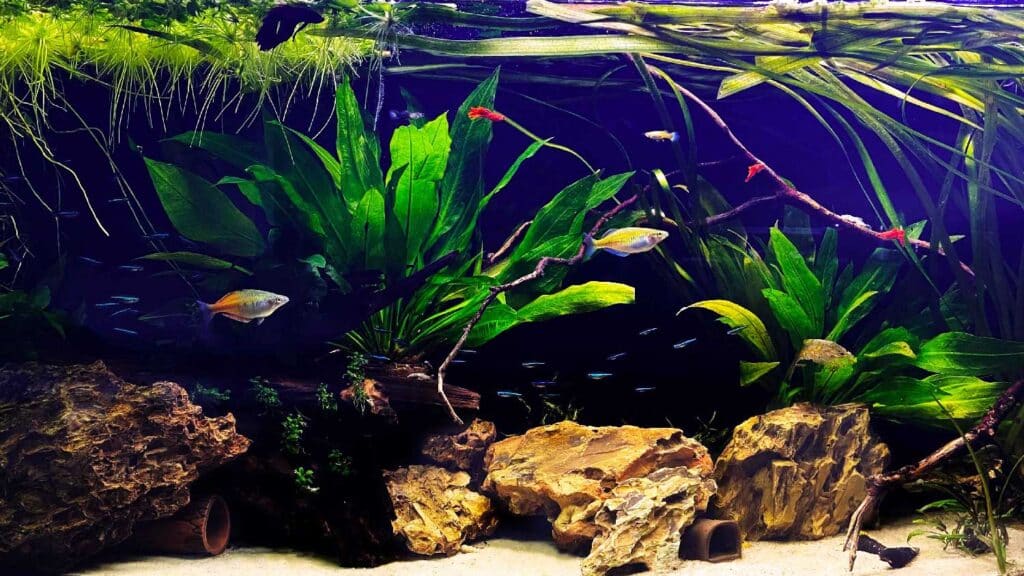
Types of Aquarium Plants for Livebearers
The ideal type of plant for a livebearer breeding tank is the plant that needs low maintenance and can grow densely to be able to protect the fry. These plants also need to be hardy enough to tolerate the different conditions that can happen in a breeding tank.
Generally, any densely grown plant can do the trick. But the denser the plant is, the more fry can survive. So Here are our top picks of plants for a livebearer breeding tank:
1. Guppy Grass (Najas guadalupensis)
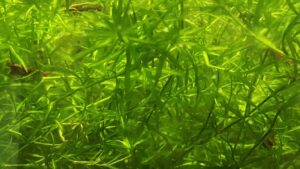
Najas Grass or Guppy Grass is a fast-growing aquatic plant commonly used in breeding setups. Because of this, they gained the name “Guppy Grass” as they are mainly used in guppy tanks.
This plant is prized by many aquarists for its fast and dense growth. This plant is also known by other names such as Southern Water Nymph, Water Nymph, Common Water Nymph, and Najas grass.
They are very low-maintenance plants that grow rapidly when enough light and fertilizer are available. This is all they need to grow!
Guppy grass’s bushy growth gives livebearer fish like guppies and other fish a safe place to breed, hide, and grow. It provides an ideal growing place for fry, keeping them safe from larger fish.
For more information please read our full guide on Guppy Grass.
2. Hornwort (Ceratophyllum species)
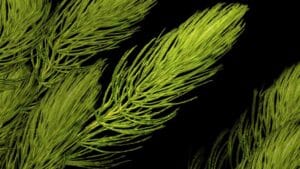
Hornwort (Ceratophyllum demersum) is another popular aquarium plant that can be used in breeding tanks. This plant is sold at just about any pet store and is very cheap to buy.
It’s common to see them labeled as hornwort, coontail, or coon’s tail in pet stores. But they all are the same plant.
This beautiful aquarium plant is a free-floating species, meaning it does not need substrate to grow. You can simply leave it in the tank floating on the surface and it will continue to grow.
It needs almost no attention from you and will grow at a fast rate when conditions are right. Its fast growth rate will keep the water cleaner and healthier for the fry.
Hornwort needs a tank with low to moderate current. The weak stems of this plant can easily break by fast-moving waters. At the same time, fry also needs slow-moving currents. This makes these plants ideal tank mates for fry.
For more information please read our full guide on Hornwort.
3. Jungle Val (Vallisneria)
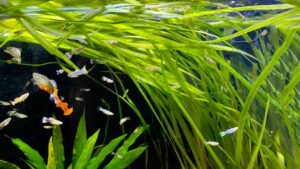
Jungle Val is an excellent aquarium plant that will grow large and tall. They will easily grow to the top of the tank and cover the surface.
They can also grow densely at the root, making it possible for the fry to hide. This plant is easy to care for and produces large leaves that will protect the fry swimming on the surface of the water.
Livebearer fry often swims to the top of the tank and tries to hide in surface floating plants. Large leaves of Jungle Val pill give the fry enough space to hide.
Keep in mind that this plant needs a large tank to grow in. So you should only use this plant if you have a large aquarium. It is also not the best plant for keeping fry safe. But surely one of the most beautiful plants you can keep. Combining other plants with Jungle Val will give the best result in saving fry from larger fish.
For more information please read our full guide on Jungle Vallisneria.
4. Java Moss
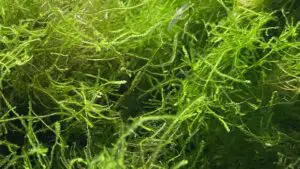
Java moss is one of the most common plants used in the breeding setup. This plant is hardy and easy to grow. Its densely grown nature will give the fry enough space to hide.
If you want to keep java moss in your livebearer tank, you must lower the intensity of the light so this moss can grow more vertically. This will give the fry more room to hide.
You can also attach this moss to different objects to create void spaces in the tank where the fry can hide. This plant is one of the most versatile species of moss you can purchase.
They are super easy to grow and do not need strong light. They are also very cheap and can be found in most aquatic pet stores.
For more information please read our full guide on Java moss.
5. Water Sprite (Ceratopteris thalictroides)
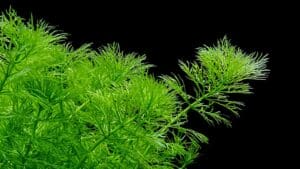
Water Sprite (Ceratopteris thalictroides) is a fern species of aquatic plant that can grow densely. This plant is used by many breeders to successfully breed livebearer fish.
It is hardy and can withstand most aquarium conditions. They are also beginner-friendly plants which makes them even more popular among new breeders.
At the same time, they’re a very affordable type of plant. They are commonly available in pet stores. Their distinct leaf structures and lush green colors will grab your attention the moment you enter the plant section of your local aquatic pet store.
For more information please read our full guide on Water Sprite Plant.
Things to Consider
Newly born fries are super sensitive and can easily get sick and die. So it is important to quarantine plants before adding them to your tank. If a plant comes in with a disease, it can kill your female even before it can give birth. The fry can also contract the disease and die after being born.
Investing in tissue culture plants is the best method for preventing this dilemma. If tissue culture plants are not available, quarantine your plants for two to six weeks before introducing them to your main breeding tank. By doing this you are eliminating the introduction of disease and parasites to your tank.
Conclusion
Livebearer fish are very easy to breed but the survival of the fry is very low if no plant is available. So you should have a sufficient amount of plants to be able to save the majority of fry. Ideally, we recommend mixing a few or all of these plants to make your tank beautiful and functional. A breeding tank doesn’t have to be ugly!